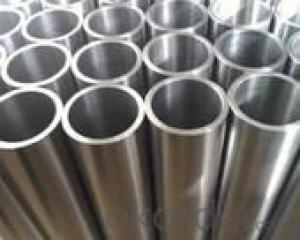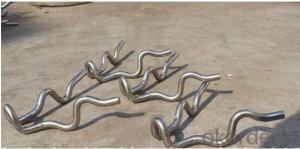STAINLESS STEEL 304 pipe materail
- Loading Port:
- China Main Port
- Payment Terms:
- TT OR LC
- Min Order Qty:
- -
- Supply Capability:
- -
OKorder Service Pledge
OKorder Financial Service
You Might Also Like
Description:
Stainless Steel Pipe
Material:
304 321 316 310
Packing:
In bundle
MOQ:
5 TONS
Comparison of standardized steels
| EN-standard Steel no. k.h.s DIN | EN-standard Steel name | SAE grade | UNS |
|---|---|---|---|
| 1.4109 | X65CrMo14 | 440A | S44002 |
| 1.4112 | X90CrMoV18 | 440B | S44003 |
| 1.4125 | X105CrMo17 | 440C | S44004 |
| | | 440F | S44020 |
| 1.4016 | X6Cr17 | 430 | S43000 |
| 1.4408 | G-X 6 CrNiMo 18-10 | 316 | |
| 1.4512 | X6CrTi12 | 409 | S40900 |
| | | 410 | S41000 |
| 1.4310 | X10CrNi18-8 | 301 | S30100 |
| 1.4318 | X2CrNiN18-7 | 301LN | |
| 1.4307 | X2CrNi18-9 | 304L | S30403 |
| 1.4306 | X2CrNi19-11 | 304L | S30403 |
| 1.4311 | X2CrNiN18-10 | 304LN | S30453 |
| 1.4301 | X5CrNi18-10 | 304 | S30400 |
| 1.4948 | X6CrNi18-11 | 304H | S30409 |
| 1.4303 | X5CrNi18-12 | 305 | S30500 |
| | X5CrNi30-9 | 312 | |
| 1.4541 | X6CrNiTi18-10 | 321 | S32100 |
| 1.4878 | X12CrNiTi18-9 | 321H | S32109 |
| 1.4404 | X2CrNiMo17-12-2 | 316L | S31603 |
| 1.4401 | X5CrNiMo17-12-2 | 316 | S31600 |
| 1.4406 | X2CrNiMoN17-12-2 | 316LN | S31653 |
| 1.4432 | X2CrNiMo17-12-3 | 316L | S31603 |
| 1.4435 | X2CrNiMo18-14-3 | 316L | S31603 |
| 1.4436 | X3CrNiMo17-13-3 | 316 | S31600 |
| 1.4571 | X6CrNiMoTi17-12-2 | 316Ti | S31635 |
| 1.4429 | X2CrNiMoN17-13-3 | 316LN | S31653 |
| 1.4438 | X2CrNiMo18-15-4 | 317L | S31703 |
| 1.4362 | X2CrNi23-4 | 2304 | S32304 |
| 1.4462 | X2CrNiMoN22-5-3 | 2205 | S31803/S32205 |
| 1.4539 | X1NiCrMoCu25-20-5 | 904L | N08904 |
| 1.4529 | X1NiCrMoCuN25-20-7 | | N08926 |
| 1.4547 | X1CrNiMoCuN20-18-7 | 254SMO | S31254 |
Stainless steel’s resistance to corrosion and staining, low maintenance and familiar lustre make it an ideal material for many applications. There are over 150 grades of stainless steel, of which fifteen are most commonly used. The alloy is milled into coils, sheets, plates, bars, wire, and tubing to be used in cookware, cutlery, household hardware, surgical instruments, major appliances, industrial equipment (for example, in sugar refineries) and as an automotive and aerospace structural alloy and construction material in large buildings. Storage tanks and tankers used to transport orange juice and other food are often made of stainless steel, because of its corrosion resistance. This also influences its use in commercial kitchens and food processing plants, as it can be steam-cleaned and sterilized and does not need paint or other surface finishes.
Stainless steel is used for jewelry and watches with 316L being the type commonly used for such applications. It can be re-finished by any jeweler and will not oxidize or turn black.
Some firearms incorporate stainless steel components as an alternative to blued or parkerized steel. Some handgun models, such as the Smith & Wesson Model 60 and the Colt M1911 pistol, can be made entirely from stainless steel. This gives a high-luster finish similar in appearance to nickel plating. Unlike plating, the finish is not subject to flaking, peeling, wear-off from rubbing (as when repeatedly removed from a holster), or rust when scratched.
- Q: Are stainless steel pipes recyclable?
- Yes, stainless steel pipes are recyclable. Stainless steel is a highly sustainable material that can be recycled repeatedly without losing its properties or quality. Recycling stainless steel pipes helps conserve resources, reduce waste, and minimize environmental impact.
- Q: What is the difference between the stainless steel tube and tube rolling
- Stainless steel seamless pipe manufacturing process at home is divided into hot and cold drawing tube, two pieces of process what is the difference between the use of the same? Let's make a brief introduction.
- Q: Can stainless steel pipes be insulated with polylactide-co-glycolide?
- Polylactide-co-glycolide (PLGA) is not suitable for insulating stainless steel pipes. PLGA is mainly employed in medical applications, like drug delivery systems and tissue engineering, rather than insulation. Insulating pipes necessitates materials with excellent thermal properties that can endure high temperatures, while also being resistant to moisture and durable. There are insulation materials specifically designed for stainless steel pipes, such as foam insulation or fiberglass insulation, which would be more appropriate choices.
- Q: What are the different types of stainless steel pipe coatings?
- There are several types of stainless steel pipe coatings that are used to enhance the durability, corrosion resistance, and aesthetic appearance of the pipes. Some of the common types of stainless steel pipe coatings include: 1. Fusion Bonded Epoxy (FBE) Coating: FBE coating is a thermosetting resin-based coating that is applied to the pipes using an electrostatic spray. It provides excellent corrosion resistance and adhesion, making it suitable for both buried and above-ground applications. 2. Polyethylene (PE) Coating: PE coating is a thermoplastic coating that is applied to the pipes using extrusion. It provides high impact resistance and excellent resistance to chemical substances, making it suitable for pipes used in harsh environments. 3. Polypropylene (PP) Coating: PP coating is a thermoplastic coating similar to PE coating but with higher temperature resistance. It is often used for pipes that transport high-temperature fluids. 4. Polyurethane (PU) Coating: PU coating is a thermosetting resin-based coating that is applied to the pipes using a spray or dip method. It provides excellent resistance to abrasion, impact, and chemicals, making it suitable for pipes used in demanding applications. 5. Zinc Coating: Zinc coating, also known as galvanization, is a metallic coating that is applied to the pipes using a hot-dip process. It provides excellent corrosion resistance and is commonly used for pipes used in outdoor and underground applications. 6. Ceramic Coating: Ceramic coating is a high-temperature resistant coating that is applied to the pipes using a thermal spray process. It provides excellent resistance to abrasion, oxidation, and corrosion, making it suitable for pipes used in high-temperature environments. 7. PTFE (Polytetrafluoroethylene) Coating: PTFE coating is a non-stick coating that is applied to the pipes using a spray or dip method. It provides excellent resistance to chemicals and high temperatures, making it suitable for pipes used in the chemical and food industries. These are just a few examples of the different types of stainless steel pipe coatings available. The choice of coating depends on the specific requirements of the application, such as the type of fluid being transported, the operating temperature and pressure, and the environmental conditions.
- Q: How do you prevent galling in stainless steel pipes?
- One way to prevent galling in stainless steel pipes is by applying an anti-seize compound or lubricant to the threaded connections. This helps to reduce friction and prevents the surfaces from seizing together. Additionally, ensuring proper thread engagement and avoiding excessive tightening can also help prevent galling.
- Q: Can stainless steel pipes be used for solar thermal systems?
- Yes, stainless steel pipes can be used for solar thermal systems. Stainless steel is a popular choice for solar thermal system piping due to its corrosion resistance, durability, and ability to withstand high temperatures. Solar thermal systems use heat from the sun to generate hot water or provide space heating, and stainless steel pipes are able to handle the high temperatures and pressures involved in these systems. Additionally, stainless steel pipes have a long lifespan, which makes them a reliable choice for solar thermal applications.
- Q: Are stainless steel pipes suitable for solar power systems?
- Yes, stainless steel pipes are suitable for solar power systems. Stainless steel is known for its exceptional resistance to corrosion, which makes it an ideal choice for solar power systems that are exposed to various weather conditions. Solar power systems often require the transportation of fluids, such as water or heat transfer fluids, and stainless steel pipes can effectively handle these requirements. Additionally, stainless steel pipes are durable and have a long lifespan, ensuring the longevity and efficiency of the solar power system. Furthermore, stainless steel is a sustainable and environmentally friendly material, aligning well with the renewable energy goals of solar power systems. Overall, stainless steel pipes are a reliable and suitable choice for solar power systems.
- Q: Can stainless steel pipes be used in the food processing industry?
- Yes, stainless steel pipes are commonly used in the food processing industry due to their corrosion resistance, hygienic properties, and durability. Stainless steel is non-reactive, does not leach chemicals into food, and can withstand high temperatures and frequent cleaning, making it an ideal material for transporting food and beverages safely.
- Q: What are the different grades of stainless steel pipes?
- There are several different grades of stainless steel pipes available, each with its own unique properties and applications. The most commonly used grades include: 1. Grade 304: This is the most widely used stainless steel grade for pipes. It offers excellent corrosion resistance, good heat resistance, and high strength. Grade 304 is suitable for a wide range of applications, including water pipes, food processing equipment, and architectural structures. 2. Grade 316: This grade is known for its superior corrosion resistance, particularly in environments with high chloride content. Grade 316 pipes are often used in marine applications, chemical processing plants, and medical equipment where resistance to pitting and crevice corrosion is crucial. 3. Grade 321: This grade is stabilized with titanium, which makes it resistant to intergranular corrosion after exposure to high temperatures. Grade 321 pipes are commonly used in applications involving elevated temperatures, such as exhaust systems, furnace parts, and heat exchangers. 4. Grade 409: This grade is specifically designed for high-temperature applications such as automotive exhaust systems. It offers good heat resistance and is highly resistant to corrosion and oxidation. 5. Grade 904L: This grade is a highly alloyed austenitic stainless steel that provides excellent resistance to a wide range of corrosive environments, including sulfuric acid, phosphoric acid, and chloride solutions. Grade 904L pipes are often used in chemical processing plants, pulp and paper industry, and desalination plants. It is important to select the appropriate grade of stainless steel pipe based on the specific requirements of your application to ensure optimal performance and longevity.
- Q: Can stainless steel pipes handle high temperatures?
- Stainless steel pipes possess the ability to endure high temperatures. The exceptional heat resistance of stainless steel makes it suitable for a wide range of applications involving elevated temperatures. The maximum temperature the pipes can withstand is determined by the specific grade of stainless steel employed. For example, austenitic stainless steel grades like 304 and 316 are typically capable of handling temperatures up to approximately 1600°F (870°C), whereas higher alloyed grades such as 310 and 321 can withstand even higher temperatures. This heat resistance is attributed to the presence of chromium and other alloying elements in stainless steel, which create a protective oxide layer that prevents corrosion and oxidation at high temperatures. Consequently, stainless steel pipes find common use in industries like petrochemical, power generation, and heat exchangers, where high temperatures are prevalent.
Send your message to us
STAINLESS STEEL 304 pipe materail
- Loading Port:
- China Main Port
- Payment Terms:
- TT OR LC
- Min Order Qty:
- -
- Supply Capability:
- -
OKorder Service Pledge
OKorder Financial Service
Similar products
Hot products
Hot Searches
Related keywords


























